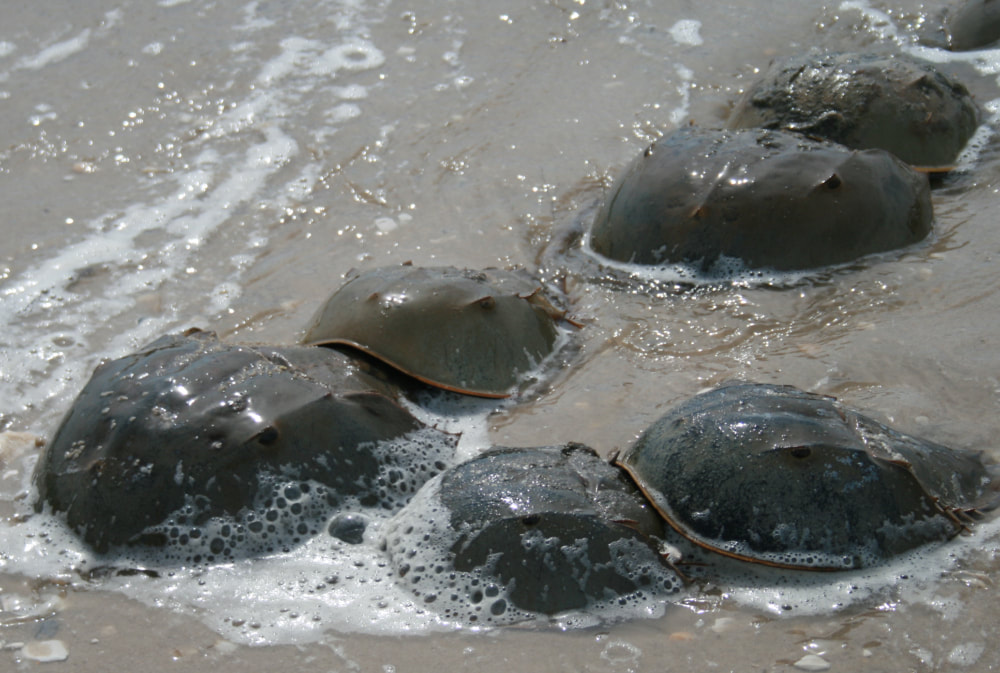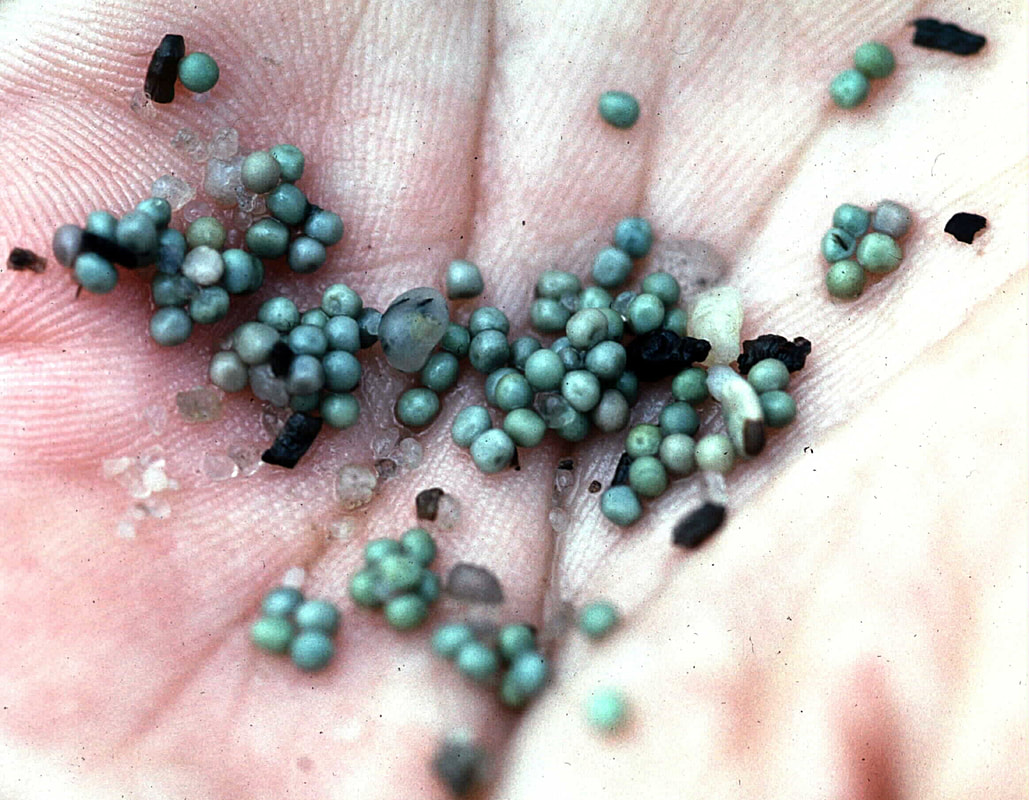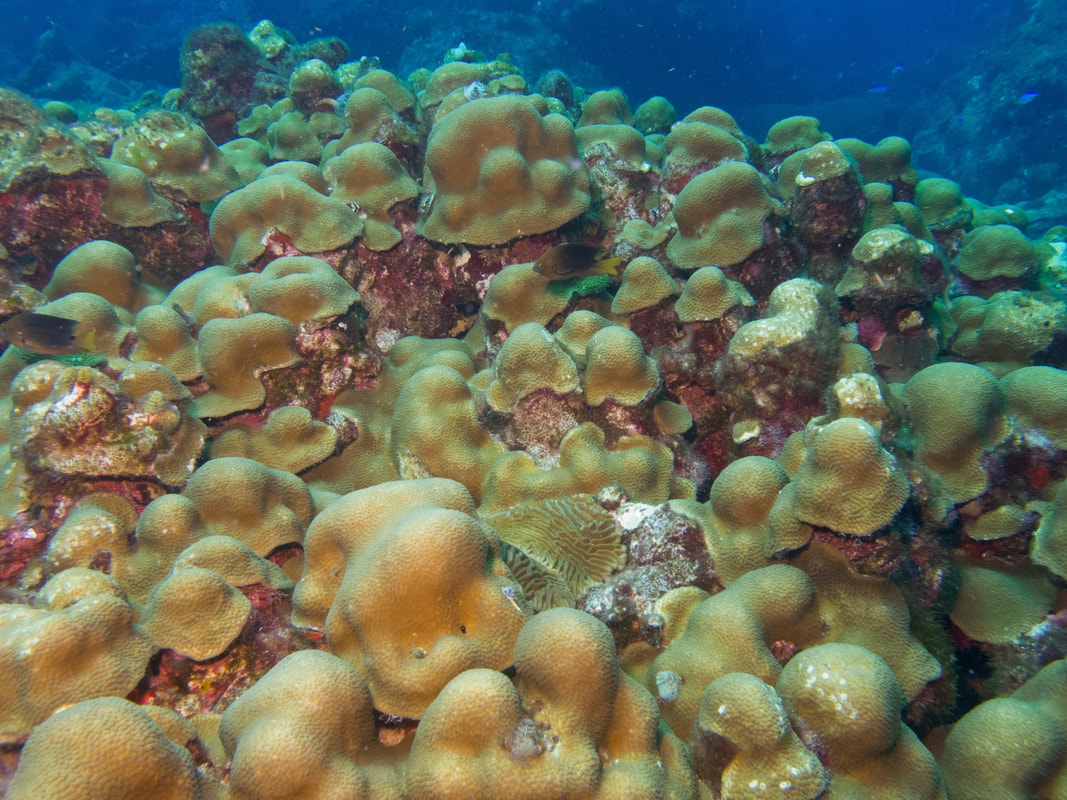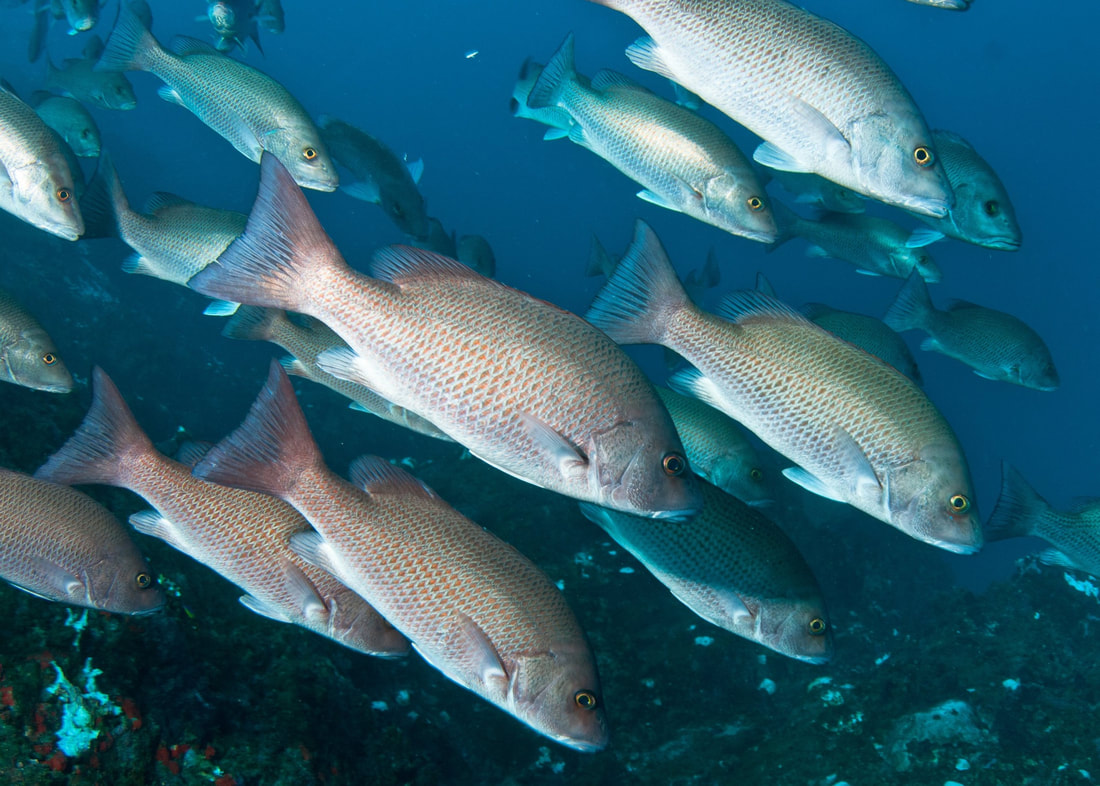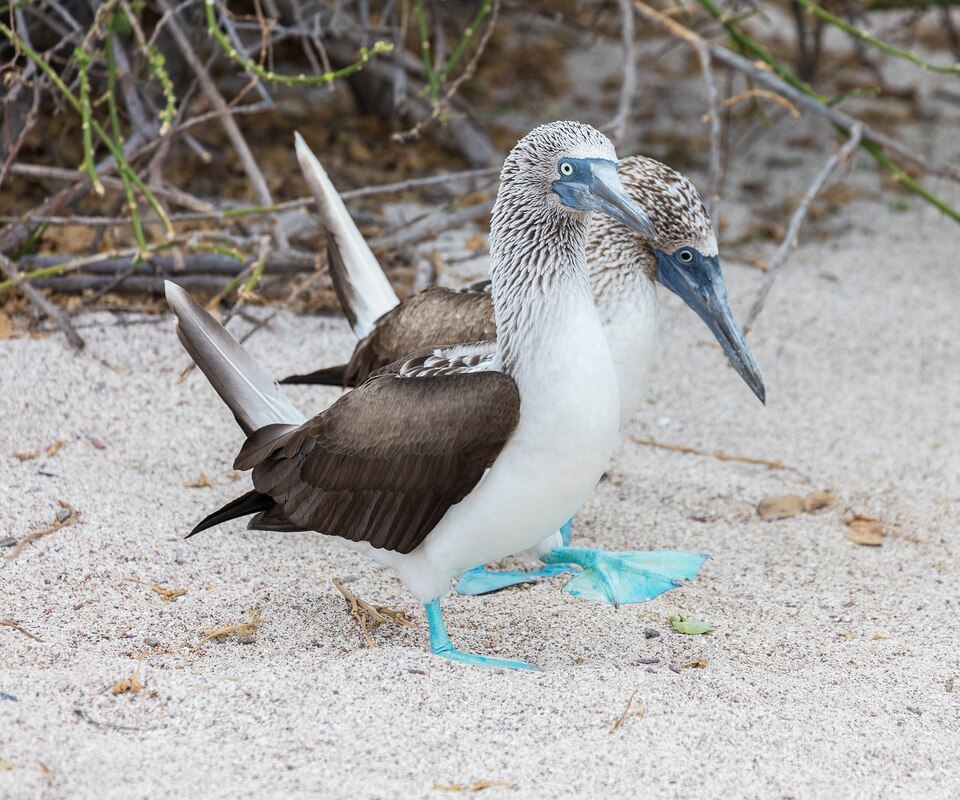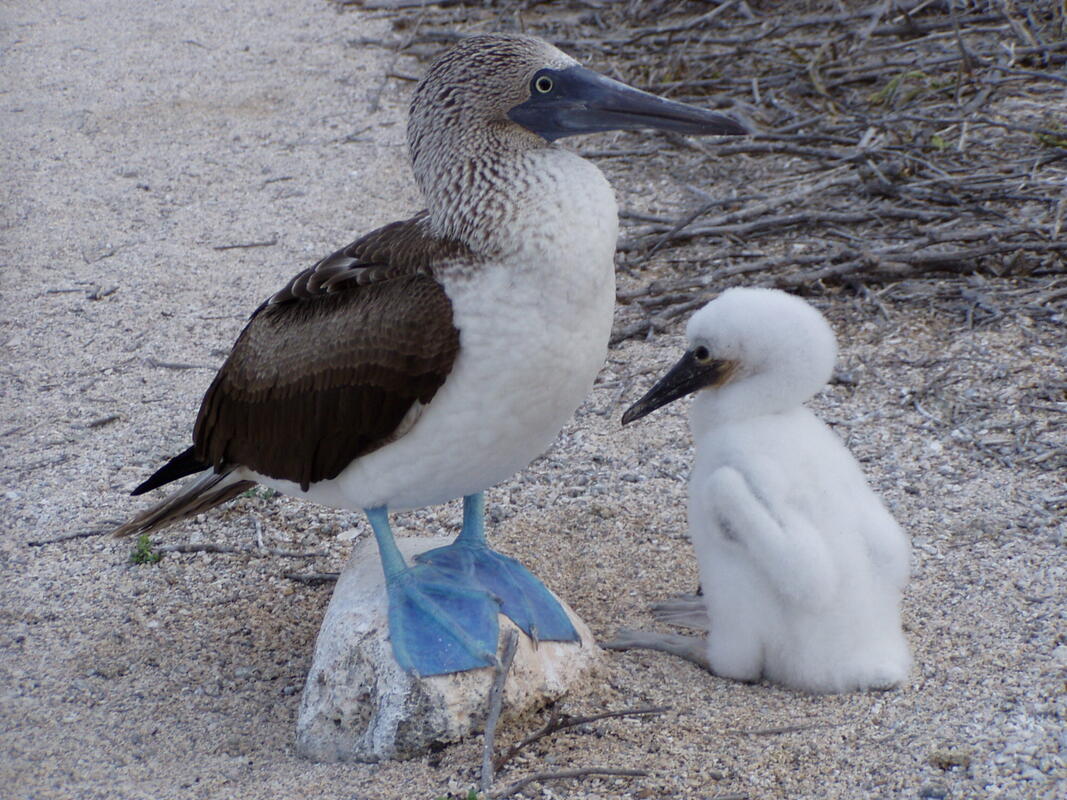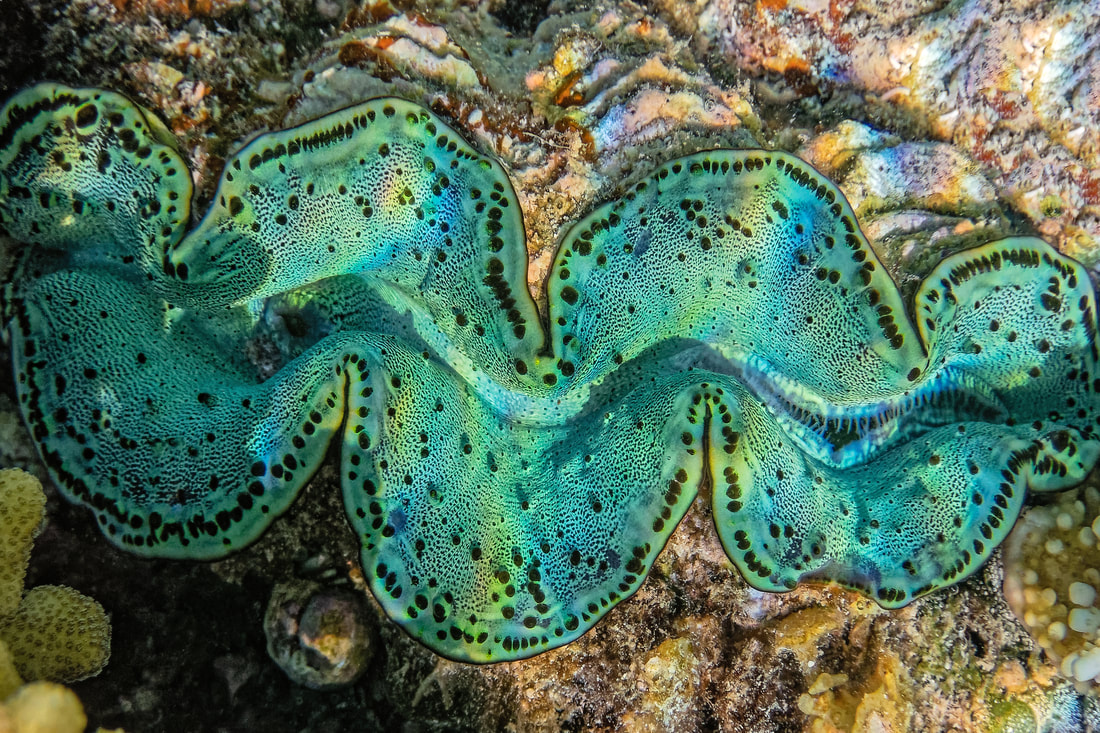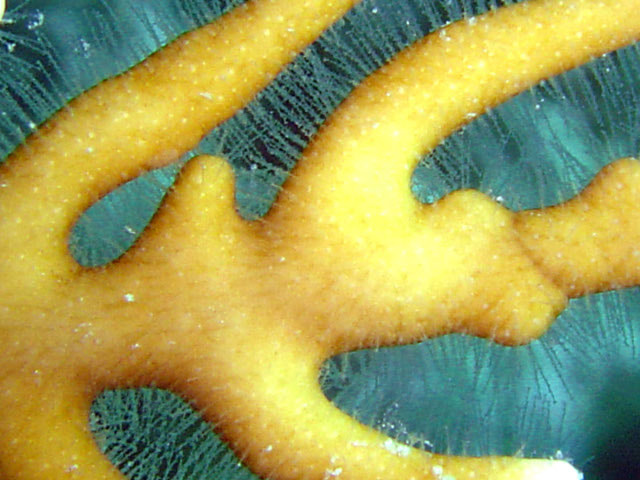|
Mating American Horseshoe Crabs (Limulus polyphemus) in Delaware Bay, south New Jersey, U.S.A. Photograph by Asturnut (talk) - I (Asturnut (talk)) created this work entirely by myself., CC BY-SA 3.0, https://en.wikipedia.org/w/index.php?curid=27534108 Worldwide there are four living species of horseshoe crabs and all exhibit reproductive habits unique set of reproductive habits unlike other arthropods; they exhibit amplexus (see above - males attach to females) broadcast spawning, and do not brood the eggs. Mating horseshoe crabs primarily form pairs with the smaller males using specialized appendages to attach to the larger females. These pairs migrate to shallow water or onto beaches during high tides where females scoop out shallow nests in the sand before injecting tens of thousands of eggs into the sediment in clusters. Males release their free-swimming gametes and eggs are fertilized either within the water or the sediment. Horseshoe crab eggs in hand. Mispillion Harbor, Delaware. Credit: Gregory Breese/USFWS Public Domain Photograph downloaded from https://www.flickr.com/photos/usfwsnortheast/4035580656 The young horseshoe crabs develop 7 to 20 cm (≈ 3 – 8 in.) within the sediment over a period of three to four weeks and emerge during periods of high tides or heavy wave action. While the primary spawning season is The larvae’s lack of a “tail” or telson gives them the appearance of the extinct arthropod group by that name. The trilobite larvae are semi-plankton for several days before molting and assuming the role of a benthic juvenile horseshoe crabs. The juveniles inhabit shallow water in the vicinity of their birth beaches and feed on smaller benthic organisms and organic detritus. As they grow larger they move into deeper water and only return to shallower estuaries for spawning. Horseshoe crabs spawn primarily during the spring and early summer, although late season spawning can produce larvae that hatch and spend within the beach sediment. American horseshoe crabs are important members of the ecological communities of the Atlantic and Gulf coasts. Their eggs are eaten by invertebrates and fish and they are a key food source for migrating shorebirds stopping off in the Delaware Bay region during the spring. Newly hatched trilobites are also eaten in large numbers by both fish and invertebrates. Adults horseshoe crabs are reported prey of American alligators (Alligator mississippiensis) in Florida’s Indian River Lagoon and by loggerhead turtles (Caretta caretta) in lower Chesapeake Bay. The adults horseshoe crabs have a strong influence on benthic communities by both their feeding on various bivalve species and through the disturbance of sediment during feeding. The exoskeletons of adults also serve as habitat for organisms needing a hard surface in a soft sediment habitat. Epibionts gain both a firm and mobile attachment surface. Once a Spawn a Time: Horseshoe Crabs Mob the Beach
0 Comments
Photo credit: Ryan Eckert/FGBNMS] — at NOAA's Flower Garden Banks National Marine Sanctuary. Lobed star coral (Orbicella annularis), also known as the boulder star coral, inhabits the tropical and subtropical regions of the western Atlantic, including the Gulf of Mexico and Caribbean Sea and Bermuda. It is reported to be the most abundant, and best studied of the reef-forming corals in the region.
Molecular studies of the Lobed star coral has recently determined that the “species” is actually a complex of three species; O. annularis, O. faveolata, and O. franksi. They are difficult to distinguish between in the field due to the differences at the genetic level, subtle morphological distinctions, and variations in the growth form based on light levels, among other factors. The O. annularis species complex has a wide depth range, being found from the low tide level down to as deep as 82 meters (≈ 270 ft.). The colonies can grow in a number of different shapes, including boulders, heads, plates and the “lumpy” type seen in the photo. These variations are attributed to differences in amount of sunlight that can reach the colony. Colonies can grow to up to grow to a diameter of 10 meters (≈ 33 ft.) and a height of 4 to 5 meters. (≈ 16 ft.). They can also live for hundreds of years and are important to providing framework for western Atlantic reefs. Unfortunately, Lobed star coral is listed as threatened under the Endangered Species Act and Endangered by the IUCN. Threats to its existence include warming oceans, increasing ocean acidity, algal overgrowth, sedimentation and pollution. Older folks may also know it by its original scientific name, Montastrea annularis. Photo credit: Ryan Eckert/FGBNMS Gray Snappers (Lutjanus griseus) are some of the smaller and slimmer members of the snapper family Lutjanidae. Most grey snappers grow as long as 40 cm (16 in) although there are records of large individuals up to 89 cm (35 in).
Adults occupy a wide variety of coastal and offshore habitats ranging from mangroves, hardgrounds, coral reefs and human constructs such as ship wrecks, canals and harbors. Inshore habitats like seagrass beds, mangrove and also are found patrolling sandy and muddy bottoms. Both young and old have a wide tolerance for low salinities, being found in estuaries, rivers and even freshwater lakes in Florida. Adults have a depth range of 5 to 180 meters (≈16 – 591 ft), but are most frequently occur in less than 50 m (160 ft) of water. During the daylight hours, gray snappers for schools that tuck up close to vertical structures like mangrove roots, coral heads, pilings, canal walls or wrecks. These schools disperse at night as the individual fish move out to forage for prey that include small fishes, crustaceans, gastropods, and cephalopods. They are a western Atlantic species that occurs from Bermuda, to Massachusetts south to Florida, the Bahamas, the Gulf of Mexico, Caribbean Sea, and southward to Brazil. Due to this wide geographic range and its importance as a recreational and commercial species, the gray snapper has a very large number of common names including the following:
The blue-footed booby (Sula nebouxii) is a large, charismatic seabird that is found in the tropical and subtropical eastern Pacific Ocean. It is one of three booby species found on the Galapagos Islands, and is perhaps the most famous of all the Galapagos birds. From the Galápagos Islands their geographic range extends northward to the coast of Baja California and western the coasts of Central and South America. The most distinctive feature of the blue-footed booby is its bright blue feet. The color of the feet comes from a pigment called pteridine, which is also found in the feathers of other birds, such as the scarlet macaw. The blue-footed boobies' diet plays a significant role in the coloration of their feet. These birds primarily feed on fish, particularly species like sardines and anchovies. The fish they consume contain pigments called carotenoids, which are responsible for various colors in nature, including the blues and greens seen in many birds. The carotenoids from their fishy diet are metabolized by the birds' bodies and accumulate in the skin, particularly in the feet, resulting in the blue coloration. The intensity of the blue color in a blue-footed booby's feet is directly related to its health and nutritional status. A more vibrant blue color indicates a healthier individual with access to a diet rich in carotenoids. This coloration serves as a visual signal to potential mates during courtship. Males with brighter blue feet are perceived as more attractive and capable of providing for their partners and offspring. During mating rituals, male birds show off their feet to prospective mates with a high-stepping strut. Blue-footed boobies are one of the few bird species that can actually blush. When a male booby is feeling particularly proud of his feet, he will often blush blue. This is thought to be a way of attracting the attention of potential mates. The blue-footed booby breeds year-round. The male and female birds build a nest together where the female lays one to three eggs. Both parents incubate the eggs which hatch after about 45 days and both parents are involved in feeding. The first hatch chick usually establishes a dominance hierarchy and is the recipient of the majority of the food. Fratricide by the older chick is also not uncommon. Surviving chicks will fledge after about 102 days. Parents continue to provide food until the chicks are fully independent. Blue-footed boobies spend the night ashore in their nest and when day breaks they take to the air in search of seafood, often fishing in large, cooperative groups. Eye placement on both sides of the bill with a forward orientation gives these birds excellent binocular vision, essential for hunting fish from the air They feeding primarily by plunge diving. Once prey are spotted they will fold their long wings back around their streamlined bodies and plunge into the water from as high as 24 meters (≈ 80 ft). Their speed entering the water reaching 96 km/hr (≈ 60 mile/hr). Adaptions to such a violent entry include padding in the form of subcutaneous fat, well-developed air sacs and closed external nostrils. The pursuit of a meal may take them as deep as 20 M (≈ 65 ft). Prey items are pelagic fish such as pilchards (Sardinops caeruleus), chub mackerel (Scomber japonicus), anchovies (Anchoviella sp.) and flying fishes (Exocoetus sp.). The origin of the name "booby" is believed to be derived from the Spanish word "bobo," meaning foolish or clownish. The clownish nature of these graceful flyers’ gait on land is one possible source of the name, with the other being the birds’ foolish choice of landing on sailing ships where their awkwardness made them easy sources of fresh food for sailors.  An Adult Bird Photo by Dave Govoni at Flickr - https://www.flickr.com/photos/dgovoni/2187740986 https://www.flickr.com/.../dgo.../2187740986/in/photostream/  Close Up of Feet Photo by putneymark, CC BY-SA 2.0 <https://creativecommons.org/licenses/by-sa/2.0>, via Wikimedia Commons Blue-Footed Booby Mating Dance. Photo by Diego Delso, CC BY-SA 4.0 <https://creativecommons.org/licenses/by-sa/4.0>,via Wikimedia Commons https://commons.wikimedia.org/wiki/File:Piquero_patiazul_(Sula_nebouxii),_isla_Lobos,_islas_Gal%C3%A1pagos,_Ecuador,_2015-07-25,_DD_34.JPG  Diving Blue-Footed Booby Photo by Mike's Birds from Riverside, CA, US, CC BY-SA 2.0 <https://creativecommons.org/licenses/by-sa/2.0>, via Wikimedia Commons https://commons.wikimedia.org/wiki/File:Blue-footed_booby_(47937627992).jpg Distribution Map of Blue-Footed Booby: Red indicates nesting areas and blue indicates feeding areas.
Map by Jonathan Hornung, Public domain, via Wikimedia Commons - https://commons.wikimedia.org/wiki/File:Blaufu%C3%9Ftoelpel_(Sula_nebouxii)_world2.pngDistribution Map of Blue-Footed 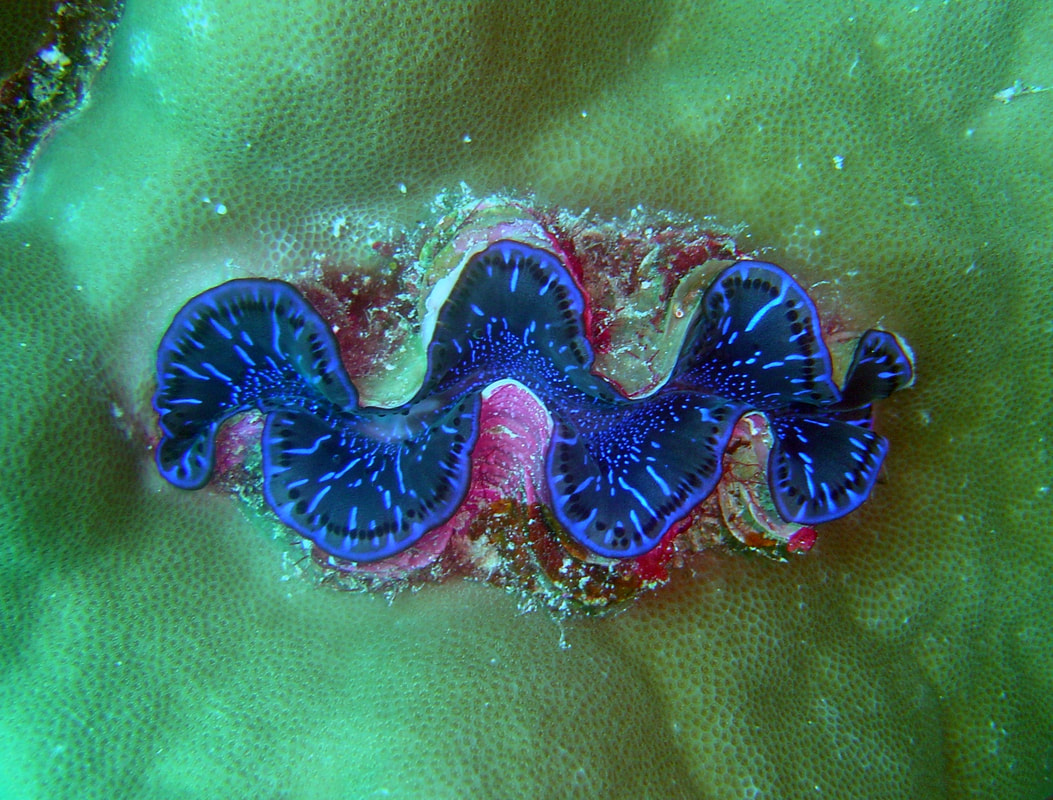 The electric blues of a juvenile giant clam (Tridacna sp.) stand out sharply from the surrounding coral off the island of Pohnpei, Federated States of Micronesia. Source: David Burdick., Public domain, via Wikimedia Commons https://commons.wikimedia.org/wiki/File:Reef1427_-_Flickr_-_NOAA_Photo_Library.jpg More color variations in the mantle of this Tridacna gigas. Photographer Globus 60 Downloade under Standard Rights from Depositphotos.com The polychromic mantle tissues of giant clam give these Bivalves Of Unusual Size (apologies to the writers of the "Princess Bride") a growth advantage in the nutrient-poor, shallow waters of the tropical Indo-Pacific Region. These colors are the result of a symbiotic relationship between the clams and single celled algae that live within the clams’ tissues.
The mantle is an important organ for all mollusks; in bivalves it covers their internal organs, creates a filter chamber and secretes the shell. Most bivalves minimize the amount of mantle they expose to the external environment, however giant clams have gone in the opposite direction and maximized the amount of mantle that can be reached by the sun. Most bivalved mollusks are filter feeders who pull water into their bodies through a tube-like siphon, run it across their gills to remove phytoplankton and detritus for nourishment and then remove the waste water through an outgoing siphon. In addition to filter feeding giant clams also obtain nourishment through a symbiotic relationship with photosynthetic dinoflagellates (algae) of the family Symbiodiniaceae that live within their mantles. These organisms are the same algae that form a symbiotic relationship with reef-forming corals and used to be known as zooxanthellae. Giant clams have a number of macro and micro modifications to help dinoflagellates optimize their photosynthetic production of nutrients. At the macro scale the giant clams’ shells along with their mantles and siphons are oriented toward the surface for maximum exposure to sunlight which is needed by their internal symbiotic algae. At the microscopic level the mantle contains specialized structures called iridocytes which protect the clam’s tissues from ultraviolet light and allow light to penetrate deeper into the tissue so that more dinoflagellates can use it. The iridocytes work by both reflecting and absorbing UV light. Once absorbed, the UV light is converted to visible light waves and remitted, allowing the algae to use it for photosynthesis and that our human eyes see as beautiful iridescence colors. There are a total of seven species of giant clams in two genera. The Tridacna contains five species while the Hippopus has two species. Giant clams are the largest living bivalves, growing up to 120 cm (≈ 47 in.) long and weighing more than 200 kg (440 lb.). They are distributed throughout the tropical Indo-Pacific Region, ranging from the Pitcairn Islands in the eastern Pacific to the East African coast and from the Great Barrier Reef in Australia northward to the island of Okinawa. Fire coral, the bane of water enthusiast who does not avoid contact with the reef, can make your undersea experience painful. But, on the positive side, it is a good sentinel that can help protect the fragile reef organisms from damage by snorkelers and scuba divers. Fire coral is a master of disguise with the shape of colonies varying from encrusting, to massive, to blade-like or branching. These growth forms are the result of differences in between species, the type of substrate larvae settle upon and/or the hydrodynamic conditions of the local area. The best way to identify generic, don't-touch-me fire coral in the field is, in my opinion, to look for brown or yellow objects bearing white tips. Fire corals and hard corals (stony coral, hermatypic coral, and reef-building coral are synonyms) are in two different Cnidarian subphyla, despite both producing skeletons of calcium carbonate and having a symbiotic relationship with zooxanthellae. Fire corals are classified as members of subphylum Medusozoa (jellyfish and hydrozoans), class Hydrozoa, order Anthoathecata while hard corals are members of the subphylum Anthozoa, class Hexacorallia, order Scleractinia. The genus name Millepora, meaning “thousands of pores”, reflects the fact that the smooth surface of fire coral colonies are covered by thousands of tiny pores. There are three types of pores; gastropores, dactylopores, and ampullae. Dactylopores house the dactylozooids, the tall, thin polyps containing nematocysts. These stinging cells capture zooplankton and protect the colony. When expended, their hair-like bodies give fire coral a fuzzy appearance. Once captured by the dactylozooids, prey are transferred to the mouths of the gastrozooids, who are responsible for digesting the food. The ampullae act as developmental chambers for the jellyfish-like medusa produced by asexual budding of polyps. All the polyps in the colony are interconnected by canals that run just under the surface of the skeleton. Like the majority of hydrozoans, fire coral have a life cycle that alternates between benthic polyps that reproduce asexually and planktonic medusae which reproduce sexually. Mature medusa are release by the colony into the water, where they quickly release eggs and sperm for the sexual phase of fire coral reproduction. The fertilized eggs develop into planula larvae which eventually settle on to a hard substrate where the colony develops by way of asexual reproduction. Photograph of branching Millepora alcicornis colony by Nhobgood (talk) Nick Hobgood - Own work, CC BY-SA 3.0, https://commons.wikimedia.org/w/index.php?curid=11449048 Photograph of branching Millepora alcicornis, dactylozoides by Fernándo Herránz Martín, GFDL <http://www.gnu.org/copyleft/fdl.html>, via Wikimedia Commons Millepora sp. (Encrusting Fire Coral) by Nhobgood (talk) Nick Hobgood Dactylozooids of Millepora alcicornis by Fernándo Herránz Martín
If you have spent any time in the water and tried to look around while submerged, you’ll know that nothing is in sharp focus. Even if the water isn’t making your eyes sting or otherwise irritating them, objects you try to focus on just will just not resolve into a crisp image. If you are above the surface and peer down through transparent water, objects below are in focus, so what happens to that clear vision when you dive below and try to get a closer look from within the water? And why, if you put on a mask or look porthole or the side of an aquarium, are underwater objects in focus? IT’S JUST BASIC PHYSICS The word physics can be intimidating to some of people, I get that. Fortunately, you aren’t one of those people. Optics is the branch of physics we need to look at to understand vision and the way light behaves in both air and water. Light can travel through air, water, the vacuum of space and any other transparent substance. These media all have a influence on how fast light can travel through them because the tiny packets of light called photons interact with the particles it is traveling through. Light is fastest in a vacuum because there is no matter to interact with and slow it down. The symbol scientists use for the speed of light in a vacuum is a c (it is taken from the first letter of the Latin word, celeritas meaning swiftness). The speed of light is a universal physics constant whose exact value is 299, 792,458 meter per second. BENT LIGHT When light moves from one medium to another it changes speed. The refractive index (or Index of Refraction) of a material is a number that defines how fast light travels through some medium. The refractive index is calculated by dividing the speed of light in vacuum by the speed of light in the material of interest. All transparent matter has its own, unique refractive index. Below is a table of the refractive indices of some common substances. An interesting interactive tutorial was created by Nikon allows you to how changing different variables effect animated refracting rays. SHARPER IMAGES
Notice the close the refractive index of air (1.00033) is very close to that of a vacuum (1.00000). Compare that to the refractive index of water (1.33). When a light ray enters water its velocity drops by a factor of 0.75188 times (1/1.33). This change of speed results in the bending of light rays (refraction). The “bend” you see in a drinking straw where enters the water in a glass is the result of refraction. The tissues of your eye (cornea, crystalline internal lens and the gelatinous humors) all cause light to be bend and create a focused image on your retina. Your eye is adapted to deal with light passing through air and into it. When light passes through denser water with its 1.33 refractive index the lenses in your eyes bend it at a different angle that causes the rays to form a focused image behind your retina. The image behind your retina results in a blurry image. SEEING CLEARLY NOW The best method to get view well focused images underwater is to get the air back in front of your eyes. That is where masks come into the picture. They put a pocket of air between objects you are viewing and your eye; allowing for the formation of sharp, focused images. WARNING: OBJECTS ARE CLOSER THAN THEY APPEAR But the mask also exacts a price in terms of image distortion. Objects will be magnified by 33% due to the additional refraction created by the mask’s glass and air pocket. These same objects will also appear to be 25% closer to you. Some other distortions you might notice include pincushion distortion and lateral chromatic aberration are noticeable, although these are usually not notice by recreational divers. THE BOTTOM LINE When you first start diving the image distortions produced by changes in refraction may cause you to make mistakes when estimating the size of marine life or how far an object is from you. This is nothing to worry about, as your brain soon learns to compensate for the distortions. One of the easiest ways to observe nature under the water is to use snorkeling equipment. The equipment is simple and much less expensive than scuba gear and does not require lengthy certification courses. Follow the seven steps below to make your next snorkel adventure more enjoyable.
1. Mental Preparation Mental preparation for snorkeling is step one. The first thing I tell my snorkeling and scuba students is develop the habit of assessing your personal mental state before and during a dive. Ask yourself these questions, “Do I feel safe? Am I comfortable? Am I having fun? If the answer to any of these is a no, the you should not make the dive or you should safely exit the water. Your thoughts affect your enjoyment of the dive, how you perform and how well your response to stressful situations which may arise while diving. If you feel uncomfortable don’t dive and don’t let others pressure you into diving. There is nothing wrong with sitting out or modifying a dive. 2. Physical Skills and Conditioning Do you have to be able to swim to snorkel? Sounds like a dumb question, but people ask it. The answer is yes! While you don’t have to be an Olympic swimmer like Michael Phelps, you do have to be able to do a basic flutter kick and be able to put your face in the water. The snorkeling equipment will help you adapt to the aquatic environment, but it is not a substitute for a lack of swimming skills. Being physically fit will also help with your snorkeling, making sustained swims easier. 3. Armor Up While you won’t need chain mail or plate armor, it is a good idea to use protective clothing to safeguard your skin before, during and after a dive from sun, stinging animals, body heat lose. Specialized clothing acts as barriers against the painful stings and skin damage from sunburn. You’ll learn more about sun protection in Step 4. Exposure protection is provided by wetsuits in cooler water. When you are snorkeling in warmer water there are more exposure suit choices; a rash guard top/exercise tights or a one-piece spandex dive suit work well in these environments. Some folks like to wear thin wetsuits in tropical waters to extend their snorkeling time. Whatever you choose, remember that low profile clothing made of synthetic fabrics make it easier to move through the water. 4. Reduce Radiation Exposure A major source of post-snorkel discomfort is sunburn and an increased risk of skin cancer. As a successful snorkeler you are more susceptible UV rays because the majority of time in the water is in a face-down position with your back and the back of your legs exposed, floating extremely close to the surface of the water. Protective clothing is the best shield against UV exposure because it doesn’t wash off like sunscreens. The UPF (Ultraviolet Protection Factor) rating on clothes is measure of the amount of ultraviolet light that can get through the fabric to your skin. A UPF of 50 only allows 1/50 (2%) of the UV light to penetrate, blocking the other 98%. The Skin Cancer Foundation report that UPF factors of 30 – 49 offers very good protection, while a UPF of 50. Your head can be vulnerable to UV radiation. While wearing a bandana or a hat while in the water may not be a fashion statement, you skin will thank you later. Environmentally friendly sunblock should also be applied to your face and neck. 5. Aquatic Adaptations Mask, snorkel and fins are the keys that allow you to easily transition from the land to an aquatic environment. The primary thing to consider when acquiring this gear it how it fits you. Poorly fitting equipment will take the joy out of snorkeling. I recommend you purchase personal gear from a store that specializes in dive equipment where knowledgeable employees can help ensure a correct fit. Masks The first rule of selecting a mask is to get one that fits your face. Like buying shoes, its best to try on a number of masks and settle on the one that is most comfortable and forms a seal. To see if it seals against your face, pull the strap in front of the lens, hold then mask against your face and inhale. If it sticks there while holding your breath and you don’t notice air coming you have a good fit. A quality mask with a tempered glass lens and silicon skirt will last for many years with simple care. It is also a good idea to buy some commercial mask defogger. Snorkel Snorkels let you breathe while your face is submerged so you don’t miss any amazing sights. They should fit your mouth comfortably and be sealed by your lips. They also should be attached to your mask. Fins Fins make it much easier to move through the water. They should have a snug, comfortable fit without being too tight. There are two primary types: one with a pocket that takes your entire foot and another with an open heel area and strap. I recommend that you use thin socks with the full foot fins to reduce the chance of blisters and neoprene scuba boots with the open heel fins. One advantage I have found with the open heel fin/ scuba boot combo is the extra foot protection provided by the boot when walking around before and after a dive. Snorkeling Vest If you are not a strong swimmer you might want to give a snorkeling vest a try. These inflatable vests provide buoyancy if you should become tired or have a cramp. 6. Pre-Snorkel Preparation and Planning Successful snorkeling excursions require some thought, preparation and planning. New gear requires especially requires some attention, particularly the mask. New masks, unless very carefully cleaned will be very difficult to defog. I have a whole blog post devoted to this subject. After cleaning the mask attach the snorkel to the mask strap and try out the arrangement in a pool. Adjust the snorkel so it is comfortable and comes up past the crown of your head. Adjust the mask straps so it is not overly tight. Next adjust your fins straps if you have open heel fins. Put on all the equipment and swim around the pool, adjusting as needed until you are comfortable in the gear. Regular pool swimming with snorkeling gear is great exercise that builds both confidence and stamina. Find a buddy who wants to do this with you. You should never snorkel alone and you buddy shouldn’t be pressured into being your buddy if they are uncomfortable about snorkeling. Buddies make diving more fun because you have someone with which to share the planning and diving experience. Research destinations looking for areas with easy access and calm water. Other important information to determine include rules and regulations, availability of maps of the dive area, guides to local marine life, hours of operation if it is a park or preserve and typical water conditions. 7. Safe Snorkeling Upon arriving at your snorkeling location, take a good look around at the weather and water conditions. Note such things as wind direction general sky conditions, height of waves, whether the tide is outgoing or incoming and the presence of currents. Once in the water stay face down, relax and take it slow. Minimize the chance of inhaling any stray water drops by making a “splashboard” out of your tongue. Just touch the tip of your tongue to the roof of your mouth and “sip” air around your tongue. Keeping your head in the water requires less energy and you see more underwater life. Use slow kicks and keep your arms at your side to reduce drag. Let you larger, stronger leg muscles do the work for you. Enjoy your time visiting the undersea realm! Welcome to the Undersea Naturalist Blog. You’ve likely found this corner of the Internet because you either are already in love with the amazing quantity of life underneath the waves, or are on a journey to satisfy your curiosity about one or more of the seemingly limitlessly diverse life forms that make their homes off of the coasts of the world. This blog and associated podcast will focus mainly on ocean life and the environment, although I see myself covering estuaries as well, since they’re the intermingling of salt and fresh water.
IS THIS YOU? This site is only for people who want to learn more about marine life and the environment that life inhabits. Did you want to become a marine biologist, but someone talked “sense” into you about getting a “real” job? Are you an ocean enthusiast (scuba diver, snorkeler, beachcomber, tide-pooler, boater, surfer, etc.) who wants to be more knowledgeable about the plants and animals you encounter? The Underwater Naturalist is here for you with original articles that translate the latest scientific articles into terms intelligent nonscientists can understand and a curated newsletter. Do you want mini-courses about marine biology? Those will be coming soon. CLOTHING IS NOT OPTIONAL This website is NOT about practicing public nudity in an ocean setting; that would be marine naturism. So, if you are interested in naturism, this is not the website for you. I am also not using the naturalist in any philosophical sense. WHAT IS A NATURALIST? Common definitions of the scientific use of “naturalist” include, “a person who studies nature, esp. by direct observation of animals and plants”, “a person who studies and knows a lot about plants and animals” and “a person who studies or is an expert in natural history, especially a zoologist or botanist”. This last definition best describes my conception of a naturalist because natural history “focuses on where organisms are and what they do in their environment, including interactions with other organisms” (H.W. Greene and J.B. Losos). Natural history study is primarily done in the field and by means of observation rather than preforming lab experiments. Observational tools can be as simple as your eyes and a notebook and pencil to record what you see. Additional useful tools that will allow you to expand the scope of your observations include camera, binoculars, mask, fins, snorkel, and a magnifying glass. HOW TO BECOME A NATURALIST I believe that you don’t have to hold a degree in biology or environmental science to be a naturalist. One of my foundational principles in creating the Underwater Naturalist website was that anyone, regardless of their formal education, can become a naturalist. The only necessary requirements for you to become a naturalist is the amount of curiosity you have about marine life and the ocean environment. Remember, the third definition of a naturalist listed above refers to, “a person who studies”. Don’t let the idea of studying dissuade you from becoming a naturalist. While the word “study” may bring flashbacks of unpleasant hours spent doing homework and reading uninteresting textbooks, the you most likely thought of it that way because you wanted to spend your time doing something else. Have you ever noticed that when you find something new, that you are interested in learning about that the time spent pursuing that interest just fly by? You tend to not think the time it takes to learn a new hobby or skill as wasted time because your interest in mastering a new subject keeps you engaged. TWO EASY STEPS 1. Pick a topic in which you are interested and find books and videos online or your local library that will provide you with introductory information. 2. Get out into nature as often as possible and just observe and record. Nature journaling is a great way to hone your naturalist skills of observation, recording and questioning. Writing down your observations and writing down questions that pop into your mind will focus your next round of background research. MAKING OBSERVATIONS I know some of you are thinking, “How do I make observations of the undersea environment?” And the answer is, “It depends”. It depends on several different factors. LOCATION, LOCATION, LOCATION If you live far away from the coast, you may have to limit your observational explorations to trips, whether weekend excursions or longer vacations. This can be an advantage, as you can spend time planning the trip. You can pick the geographic area you wish to travel too based on what interests you. An internet search can help you find ways to view whales, sharks, bird migrations, etc. It can also allow you to plan the type of observations you want to do, from exploring tide pools, to beach combing to snorkeling and scuba diving. Don’t forget public aquariums, which and provide undersea naturalists with closeup views of many marine creatures and loads of information about their natural history. If you live close to a coast, you can participate in explorations along the shore or into saltwater marshes. Often these areas will have parks associated with them and observation areas with signage that gives you an overview of the area. Additionally, the rangers or local conservation organizations may have organized programs designed to get people familiar with the local marine life. FULL IMMERSION Another option is to get into the water and view the animals and plants through a mask. Depending on the water temperature and conditions, snorkeling and scuba diving are ways to get underwater and observe things up close and personal. Snorkeling is the easiest method to see what goes on under the surface. however, it can be the gateway “drug” to a lifelong addiction of scuba diving. Scuba diving requires much more equipment and training than snorkeling. While snorkeling requires no certification, you should approach it like you would any outdoor aquatic activity and get good information and do some training prior to going into open water. I’ve gone over some of the basics of snorkeling here. Scuba diving requires specialized knowledge and skills that lead to a certification. You should not be diving if you are not certified, as breathing compressed air at depth can result in injury or even death. THE FINAL WORDS Now that you have some idea of what an undersea naturalist can be, you probably have some more questions. Please feel free to use the contact form on this website to submit them for future blog posts. Thanks for reading all the way to the end of this post. If you are interested in becoming a more knowledgeable undersea naturalist, please sign up for the newsletter of curated marine biology-related articles. Citation: HW Greene and JB Losos. 1988. “Systematics, natural history, and conservation.” Bioscience, 38, Pp. 458-462. |
|

